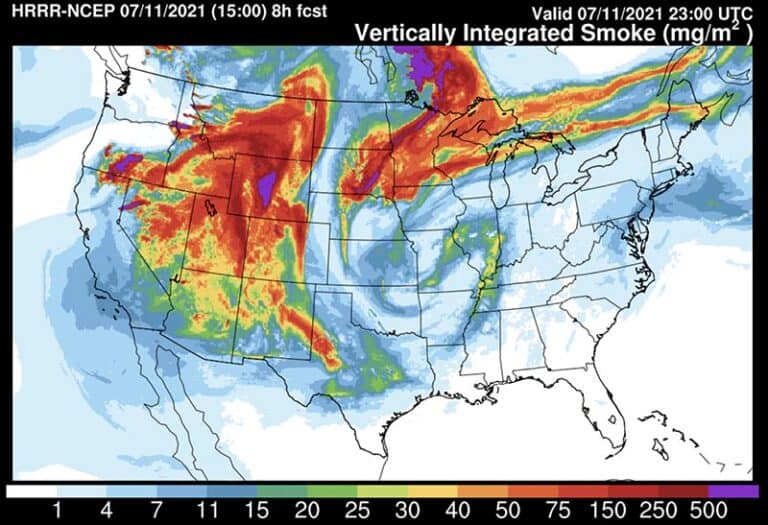
There’s a chapter in Priya Parker’s book “The Art of Gathering: Why We Meet and How it Matters.” called “Cause Good Controversy”. In it she talks about helping an architectural firm and she asked “what do you think is the most needed conversation for this group to have now?” If we think about the TSW group as a group, I’d like to ask folks what they think about this in a broader context. What are the conversations we haven’t yet had that might shed light on our ongoing disagreements? Please comment below if you have a suggestion.
As an example, I’d like to take the idea that “bad (as defined by human and ecological impacts) fires are caused by climate change.” We see this statement all the time in news stories. But perhaps there are two questions (1) “how much of what we see is caused by climate change in the broad sense (the climate is changing), (2) “what part of that specifically is caused by anthropogenic forces (including land use changes, and greenhouse gases of various kinds)?”. For whatever reason, (1) and (2) tend to get conflated in various accounts I’ve seen.
My view, based on exploring the models used in attribution studies, and having some idea about all the factors involved in big fires besides weather, is that no one really has a clue and it might not be all that helpful to pursue it because some of the uncertainty would be extraordinarily difficult to reduce, and possibly not worth the investment, when there are other questions that are more likely and more needed to be answered. But the conversation I would like to have specifically is: what difference would it make if if were 0%, 10% (caused by some mix of human factors) 30%, 50%, 70% or 100% (that would mean past fire suppression has 0 impact, which seems unlikely, but for the sake of argument..). Given that today we have what we have, and no one also understands exactly what will happen, in what timeframe, if we change greenhouse gases or other forcing agents according to what kind of timeline, how would the proportion attributed to AGW change our adaptation response to the situation we’re presented with today?
I don’t know and my thinking is “not much” but I’d like to start the conversation.
See: Connections of climate change and variability to
large and extreme forest fires in southeast
Australia
Nerilie J. Abram et al.#
COMMUNICATIONS EARTH & ENVIRONMENT | (2021) 2:8 | https://doi.org/10.1038/s43247-020-00065-8 | http://www.nature.com/commsenv
A very interesting discussion of wildfire “switches. AL
Other than individual personal sacrifices and lifestyle adjustments that minimize energy consumption/reliance and other individual actions that lessen our negative impact on the environment, there’s not a lot we can do, individually, to reduce GHGs. But, we can pool our combined resources, our experiences, observations, ideas, and personal insights to help find practical, tactical solutions to better adapt to the anticipated effects of climate change, whether or not anthropogenic sources are the underlying cause or not. We still have to deal with the impacts on the ground level, and no doubt, they will be disruptive and challenging.
I was reading a USFS paper (Soleri, D et al. 2016 Finding Pathways to More Equitable and Meaningful Public-Scientist Partnerships. Citizen Science: Theory and Practice, 1(1): 9, pp. 1–11, DOI: http://dx.doi.org/10.5334/cstp.46), and these fine points struck me:
Transdisciplinary research is a promising approach for addressing sustainability challenges arising from global environmental change. It uses an iterative process that can bring actors from multiple academic fields together and diverse sectors of society to engage in mutual learning with the intent of co-producing new knowledge.
One conceptual model is transdisciplinary collaboration using a “science with society” (SWS) approach to guide solutions.
Flexibility and collaborative spirit are often the most frequently valued skills in SWS, though non-researchers tend to prioritize attributes like humility, trust, and patience over flexibility.
There are many potentials to be gained from encouraging citizen science and broader participation with academia and field professionals to search for viable active solutions.
“Think globally, act locally.”
Thanks Michael, we’ve talked about codesign and coproduction of science quite a bit here. From Peter Gluckman of New Zealand https://forestpolicypub.com/2018/01/24/inspiring-science-co-design-and-co-producion/
All the way to Blue Mountains Partners. I hope to get some more guest posts on this next month. It seems to be something everyone agrees on.
Exhaust gases from aircraft are indeed mostly water vapor that become visible as a function of the dew point then often form cirrus clouds at higher altitudes and alter microclimates.
But in the name of geoengineering or albedo modification the US Air Force routinely sprays into the atmosphere over the ocean an aerosol cocktail of silver iodide, lead iodide, aluminum oxide, barium, frozen carbon dioxide, common salt, water and soot from burning hazardous waste in pits concocted at Air Force bases including those at Ellsworth AFB near Rapid City, South Dakota.
Later this month the USAF is scheduled to resume albedo modification maneuvers over parts of four red states. In the documents that give Ellsworth guidance in flaring off toxic materials are the words, ‘Waters of the United States’ or WOTUS.
Ellsworth AFB is home to a Superfund site so are Malmstrom AFB, Montana; Minot AFB, North Dakota and FE Warren AFB, Wyoming. All participate in the deployments over the Powder River Training Complex. General aviation, private pilots, climate watchers, even some Republican landowners and ranchers are concerned the elevated atmospheric hijinx could exacerbate drought conditions that persist in a region where dried grasses increase fire danger even in January.